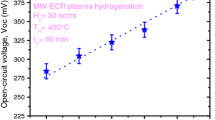Abstract
Using the hydrogen deactivation of the phosphorus donor in silicon based Schottky diodes, the diffusion of hydrogen is investigated. Hydrogenation is performed by microwave plasma discharge involving an electron cyclotron resonance system (MW-ECR) to observe the variation in different operational parameters of diodes such as starting phosphorus concentration. The analysis of this variation has been carried out by capacitance–voltage (C–V) measurements to monitor the doping activation/deactivation profiles. From these profiles, hydrogen diffusion coefficients are calculated for different dopant concentrations. They clearly show that the rates and depth of deactivation were obtained in the low starting phosphorus-doped silicon sample. Our data are explained with the assumption that hydrogen diffusion is limited by trapping at the donor sites. In this case, H+ the dominant atomic species in the MW-ECR plasma reactor becomes H0 and prefers to gain an electron to become a negative ion H− which interacts with the ionized atomic phosphorus P+ to form the PH complex. Therefore, no deeper hydrogen migration is detected for high starting phosphorus concentration. This is clarified by the build-up of a large amount of molecular hydrogen beneath the surface, which strongly hinders the diffusion of the hydrogen in the bulk. The values of hydrogen diffusion coefficient obtained in our study are in close agreement to those reported in literature.
Access this chapter
Tax calculation will be finalised at checkout
Purchases are for personal use only
Similar content being viewed by others
References
Lin, A., Wong, X., Li,Y., Chou, L.: Passivation and gettering of defective crystalline silicon solar cell. Sol. Ener. Mat. Sol. Cells 62(1–2), 149–155 (2000)
Endrös, A.: Charge-state-dependent hydrogen-carbon-related deep donor in crystalline silicon. Phys. Rev. Lett., 63(1), 70–73 (1989)
Tripathi, D., Srivastava, P.C., Chandra, S.: Hydrogen passivation studies on Pd-n-type-Si diodes. Phys. Rec. B, 39, 13420–13425 (1989)
Schroder, D.K.: Semiconductor Material and Device Characterization, p. 371. Wiley, New York- United States (2006)
Slaoui, A., Pihan, E., Ka, I., Mbow, N.A., Roques, S., Koebel, J.M.: Passivation and etching of fine-grained polycrystalline silicon films by hydrogen treatment. Sol. Ener. Mat. Sol. Cells 90, 2087–2098 (2006)
Yoon, S.F., Tan, K.H., Zhang, Q., Rusli, M., Ahn, J., Valeri, L.: Effect of microwave power on the electron energy in an electron cyclotron resonance plasma, Vacuum, 61, pp. 29–35. Elsevier, Netherlands (2001)
Johnson, N.M.: Electric field dependence of hydrogen neutralization of shallow-acceptor impurities in single-crystal silicon. Appl. Phys. Lett. 47, 874–876 (1985)
Herring, C., Johnson N.M., Van de Walle, C.G.: Energy levels of isolated interstitial hydrogen in silicon. Phys. Rev. B 12, 125209-1–12509-27 (2001)
Van de Walle, C.G., Bar-Yam, Y., Pentelides, S.T.: Theory of hydrogen diffusion and reactions in crystalline silicon. Phys. Rev. Lett. 60, 2761–2764 (1988)
Deák, P., Snyder, L.C., Corbett, J.W.: State and motion of hydrogen in crystalline silicon. Phys. Rev. B 37, 6887–6892 (1988)
Deák, P., Snyder, L.C., Lindström, J.L., Corbett, J.W., Pearton, S.J., Tavendale, A.J.: The self-trapping of hydrogen in semiconductors. Phys. Lett. A 126, 427–430 (1988)
Nickel, N.H., Anderson, G.B., Johnson, N.M., Walker, G.: Nucleation of hydrogen-induced platelets in silicon. Phys. Rev. B 62, 8012–8015 (2000)
Huang, Y.L., Ma, Y., Job, R., Fahrner, W.R.: Suppression of hydrogen diffusion at the hydrogen-induced platelets in p-type Czochralski silicon. Appl. Phys. Lett. 86, 131911–1319113 (2005)
Rizk, R., De Mierry, P., Ballutaud, D., Aucouturier, M., Mathiot, D.: Hydrogen diffusion and passivation in p- and n-type silicon. Phys. Rev. B 44, 6141–6151 (1991)
Author information
Authors and Affiliations
Corresponding author
Editor information
Editors and Affiliations
Rights and permissions
Copyright information
© 2023 The Author(s), under exclusive license to Springer Nature Switzerland AG
About this paper
Cite this paper
Ouldamer, R., Madi, D., Belfennache, D. (2023). Hydrogen Diffusion Study via Phosphorus Deactivation in n-Type Silicon. In: Hatti, M. (eds) Advanced Computational Techniques for Renewable Energy Systems. IC-AIRES 2022. Lecture Notes in Networks and Systems, vol 591. Springer, Cham. https://doi.org/10.1007/978-3-031-21216-1_71
Download citation
DOI: https://doi.org/10.1007/978-3-031-21216-1_71
Published:
Publisher Name: Springer, Cham
Print ISBN: 978-3-031-21215-4
Online ISBN: 978-3-031-21216-1
eBook Packages: Intelligent Technologies and RoboticsIntelligent Technologies and Robotics (R0)




